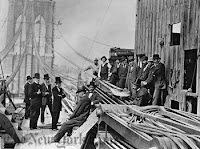When did the Brooklyn Bridge open? Did it affect the people living on the Lower East Side?
The Brooklyn Bridge opened on May 24, 1883, instantly becoming the longest bridge in the world. As the first bridge connecting the cities of Brooklyn and New York (Manhattan), it offered a cheap alternative to the ferries that daily carried men back and forth between their homes and workplaces. It was also built largely by immigrant workers, many of whom lived on the Lower East Side. When the Brooklyn Elevated to Fulton Ferry was completed in 1885, providing easy access to the interior of Brooklyn, traffic on the Bridge more than doubled, so that by 1885 it was handling some 20 million passengers a year. For this reason, it undoubtedly aided the exodus of those immigrants and children of immigrants able to afford homes in Brooklyn and the daily commute by street car into the city. While the dispersal of the Lower East Side’s German and Irish immigrant communities was already well underway, the opening the Brooklyn bridge likely hastened their exodus. But 25 years after it opened, the Lower East Side reached its peak population density.

Above: the Brooklyn Bridge under construction.
Built in 1903, the Williamsburg Bridge had a greater effect on the ability of immigrants to leave the Lower East Side. In the early 20th century, the bridge was seen as a passageway to a new life in Williamsburg, Brooklyn by thousands of Jewish immigrants fleeing the overcrowded neighborhood.
Even more important was the inauguration of the subway in 1904, whose extension over the next several decades allowed for the further decentralization of the city by making rapid transportation accessible to the working-class New Yorker. Once subway lines had been extended to places like Brownsville and East New York in Brooklyn, these areas became second Lower East Sides—immigrant neighborhoods that provided homes, workplaces, and communities to thousands of new Americans.
See the The Brooklyn Daily Eagle for further history of the borough's bridges.

No comments:
Post a Comment
Note: Only a member of this blog may post a comment.